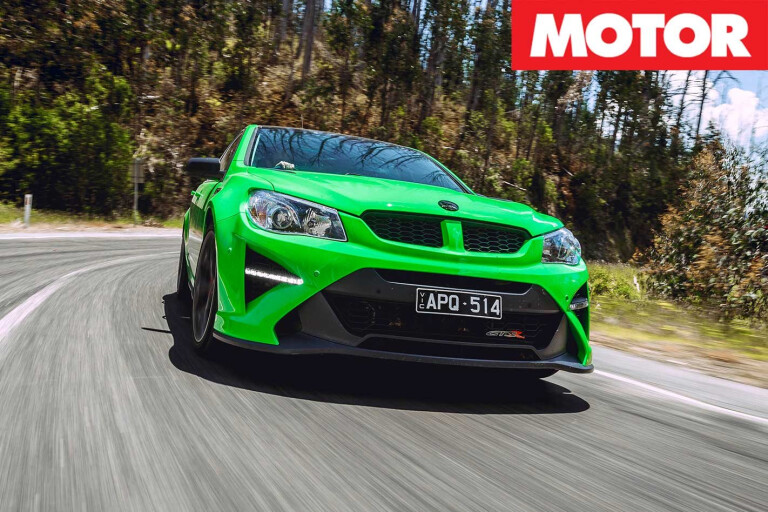
One of the most difficult decisions anyone must make is when to retire.
Whether you’re an elite sportsperson facing the prospect of ever declining skills and athleticism or John or Jane Smith simply working out how long you need to keep toiling in order to make the finances last, knowing the right time to call it quits is a tricky balancing act.
Of course, not everyone has the luxury of choosing their own terms. Just as many workers in the Australian automotive industry have been required to transition their skills into other areas or face irrelevance, HSV has been forced into a similar upheaval.
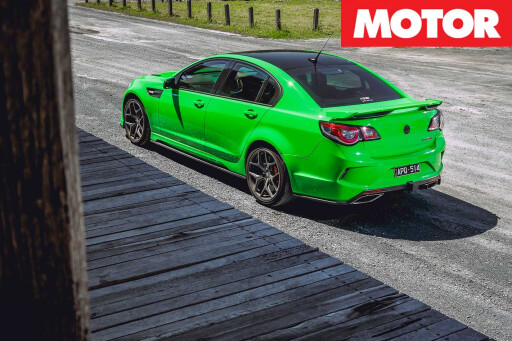 For 30 years its business has been focused on extracting the most from the Holden Commodore of the day, but the end of local manufacturing has changed the question from “What do we do to the next Commodore?” to “What do we do next?” We have covered some of the answers to that question quite extensively before, but this story is about what’s been – a final drive in the culmination of everything learned from three decades of making rear-wheel drive sports sedans.
For 30 years its business has been focused on extracting the most from the Holden Commodore of the day, but the end of local manufacturing has changed the question from “What do we do to the next Commodore?” to “What do we do next?” We have covered some of the answers to that question quite extensively before, but this story is about what’s been – a final drive in the culmination of everything learned from three decades of making rear-wheel drive sports sedans.
So much of the press and coverage regarding HSV’s final offering has been centred on the W1 and deservedly so, for as an engineering project it’s one of the biggest the company has ever undertaken. But in all the hoopla surrounding the 474kW LS9-engined monster the regular GTSR has been somewhat forgotten, which is a shame.
 Not only is it more than a GTS with an angry face and flash new colours, it’s – whisper it – arguably a more suitable, well-rounded car than its track-focused big brother for the vast majority of people. Unlike the sold-out W1, you’ll also still be able to buy one as you read this, albeit for only a short while longer.
Not only is it more than a GTS with an angry face and flash new colours, it’s – whisper it – arguably a more suitable, well-rounded car than its track-focused big brother for the vast majority of people. Unlike the sold-out W1, you’ll also still be able to buy one as you read this, albeit for only a short while longer.
This tale starts at the racetrack. It’s an appropriate venue to begin as not only is the HSV story inexorably intertwined with racing, it’s also where it began. It may not have been badged as such, but the VL SS Group A Walkinshaw was the first product from Holden’s new hot-shop following the bitter and public split with Peter Brock.
 The wild aero kit it wore was not the result of an over-enthusiastic after-work drinks session, but the by-product of wind-tunnel testing aimed at developing downforce-producing wings to battle homologation specials like the Ford Sierra Cosworth RS500 and Nissan Skyline GT-R.
The wild aero kit it wore was not the result of an over-enthusiastic after-work drinks session, but the by-product of wind-tunnel testing aimed at developing downforce-producing wings to battle homologation specials like the Ford Sierra Cosworth RS500 and Nissan Skyline GT-R.
Sandown Raceway was a relatively happy hunting ground for the Walkinshaw, Larry Perkins scoring a brace of second places in 1988 and 1989 before breaking through with victory in 1992 and the GTSR feels equally at home. Unkindly, but accurately, described by some as “two drag strips connected by a couple of squiggles”, Sandown plays to the big HSV’s strengths – big power and big brakes.
There may only be a token 5kW bump in power, but 435kW/740Nm are still very large numbers and the 6.2-litre supercharged LSA V8 is unrelenting in its urge, propelling two tonnes (with fuel and driver) well north of 200km/h on both straights with nonchalant ease.
 With the driver preference dial set to Performance, Track or ESP Off, it also sounds the part, a deep, throaty roar with an impolite blurt on upshifts if you time it right. It sheds speed as efficiently as it gains it thanks to the enormous 410mm two-piece rotors and six-piston monobloc calipers nicked from the W1. A standard GTS wears 390mm rotors and six-piston calipers, but the GTSR benefits from a much larger pad contact patch for even greater levels of retardation.
With the driver preference dial set to Performance, Track or ESP Off, it also sounds the part, a deep, throaty roar with an impolite blurt on upshifts if you time it right. It sheds speed as efficiently as it gains it thanks to the enormous 410mm two-piece rotors and six-piston monobloc calipers nicked from the W1. A standard GTS wears 390mm rotors and six-piston calipers, but the GTSR benefits from a much larger pad contact patch for even greater levels of retardation.
Once again AP Racing supplied the hardware and HSV engineering boss Joel Stoddart explains the appeal: “We’ve got a really good working relationship with [AP Racing]. We’ve got a steady engineering base and they’ve got a fairly steady engineering base, so those guys have been working together a long time and understand our requirements. The size of the company is right in the sweet spot in terms of volumes and levels of performance; if you went to a major OEM supplier our volumes don’t support that”.
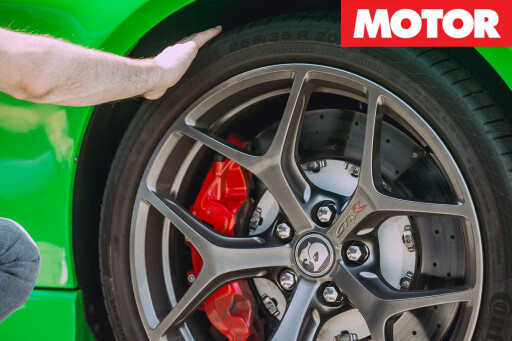 On the road the setup is arguably overkill – it’s difficult to imagine the GTS setup ever fading – but while HSV claims the new stoppers are a demonstrable improvement on track, the right tyre is needed to fully exploit the benefits.
On the road the setup is arguably overkill – it’s difficult to imagine the GTS setup ever fading – but while HSV claims the new stoppers are a demonstrable improvement on track, the right tyre is needed to fully exploit the benefits.
Continental has been HSV’s tyre partner for the entire Gen-F run (bar the W1) and while the ContiSportContact 5Ps are brilliant in the wet and offer great grip and progression in the dry (it’s not our 2017 Tyre Test champion for nothing!) the wear rate can be very high, especially when you’re dealing with a heavy, powerful car, a racetrack and temperatures in excess of 30C.
Under heavy braking it’s not hard to trigger the ABS, circumspection is needed on turn-in to prevent the heavy LSA dragging the nose wide and patience required on the throttle to ensure as many of those 435kW are transferred to the tarmac as possible.
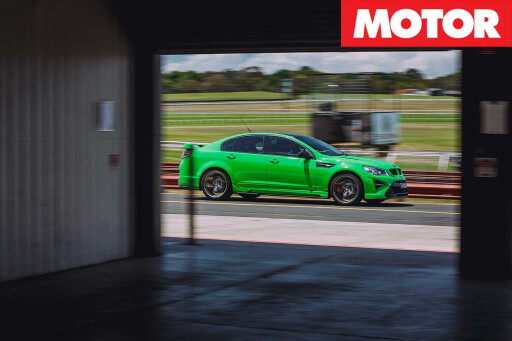 Don’t get me wrong, the GTSR is a track weapon, easily capable of embarrassing much more expensive machinery, but the quality of the brakes and chassis is such that it feels like a more focused tyre – the Pirelli Trofeo R fitted to the W1, for instance – would yield quite a significant time gain and a more stable base to push against.
Don’t get me wrong, the GTSR is a track weapon, easily capable of embarrassing much more expensive machinery, but the quality of the brakes and chassis is such that it feels like a more focused tyre – the Pirelli Trofeo R fitted to the W1, for instance – would yield quite a significant time gain and a more stable base to push against.
This is no slight on the Continental, it’s not intended to be a track-biased tyre, merely a comment that if you’re planning on tracking your GTSR – and you should, like the bloke exercising his W1 during our time at Sandown – it might pay dividends to have a dedicated set of rims and tyres. Our test car has been taken from one of HSV’s executives, the press fleet having long been re-allocated, and as a result we’ve been asked to limit laps, so we reluctantly depart Sandown for greener pastures.
Our chosen route is a well-worn one – east from Melbourne to Healesville, through the Black Spur and on to Marysville, climbing towards Lake Mountain before descending back down Reefton Spur, a 250km loop that incorporates virtually every type of corner and road surface.
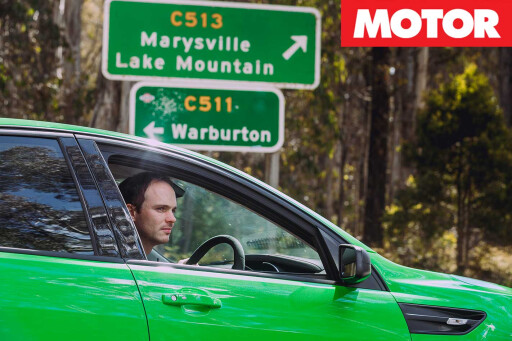 We’ve driven the GTSR before as a Maloo but only the sedan’s shorter wheelbase platform is compatible with Magnetic Ride Control, marketing-speak for the magnetorheological dampers tucked in the GTSR’s muscular wheel arches. HSV was an early adopter of the technology, which first appeared on early-2000s Cadillacs, installing it as standard on the E-Series GTS. Each damper contains magnetorheological fluid – a mixture of iron particles and synthetic oil – and a pair of electromagnetic coils, so when an electrical current is applied the fluid viscosity changes, stiffening the dampers.
We’ve driven the GTSR before as a Maloo but only the sedan’s shorter wheelbase platform is compatible with Magnetic Ride Control, marketing-speak for the magnetorheological dampers tucked in the GTSR’s muscular wheel arches. HSV was an early adopter of the technology, which first appeared on early-2000s Cadillacs, installing it as standard on the E-Series GTS. Each damper contains magnetorheological fluid – a mixture of iron particles and synthetic oil – and a pair of electromagnetic coils, so when an electrical current is applied the fluid viscosity changes, stiffening the dampers.
HSVs have always managed a reasonable compromise between handling agility and touring comfort, but the addition of adaptive suspension allowed a greater breadth of ability than ever before.
It took a little while for HSV to really nail the setup – that first E-Series GTS came 18th in the 20-strong PCOTY 2006 field – however, certainly by the time the Gen-F rolled around the trick dampers were a crucial part of being able to soak up the worst Aussie roads could throw up while also harnessing 430kW/740Nm on a track.
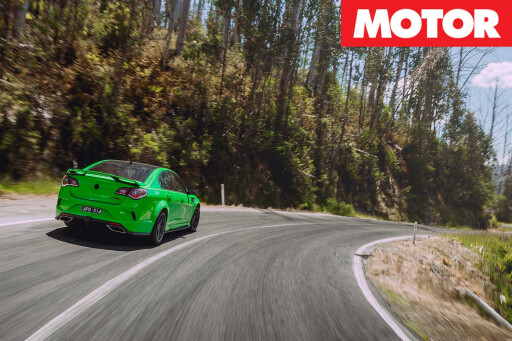 In ‘Tour’ mode the magnets are presumably dormant as the dampers are slackened off to an almost comical extent, but on a typical rolling Aussie highway or back road it’s the perfect setting for soaking up the miles, the body wallowing from bump to bump. Sadly, HSV removed Tour from MY2017 models, though it claims to have recalibrated Sport slightly to accommodate.
In ‘Tour’ mode the magnets are presumably dormant as the dampers are slackened off to an almost comical extent, but on a typical rolling Aussie highway or back road it’s the perfect setting for soaking up the miles, the body wallowing from bump to bump. Sadly, HSV removed Tour from MY2017 models, though it claims to have recalibrated Sport slightly to accommodate.
The GTSR doesn’t possess the same Al Bundy levels of relaxation as previous GTSs, but it’s still more than comfortable enough to operate as everyday family transport, not something that could be said of the super-focused W1 (though at least you’d be unlikely to hear the kids’ complains over the roar of the LS9).
Sport also lightens the steering and muffles the exhaust, at least until a big prod of the accelerator opens the bi-modal exhaust valves with a chooff.
 To be honest, Performance quickly becomes the default mode, as the slight ride quality penalty is easily compensated for by the angrier exhaust note and more lenient ESP. It also means the mechanicals are primed for immediate attack should you encounter a decent bit of road and as the Black Spur’s heavily cambered twists and turns are consumed, harder brake and throttle applications quickly bring up “Performance Shift Activated” on the central instrument display.
To be honest, Performance quickly becomes the default mode, as the slight ride quality penalty is easily compensated for by the angrier exhaust note and more lenient ESP. It also means the mechanicals are primed for immediate attack should you encounter a decent bit of road and as the Black Spur’s heavily cambered twists and turns are consumed, harder brake and throttle applications quickly bring up “Performance Shift Activated” on the central instrument display.
The 6L90E six-speed automatic isn’t exactly cutting edge in this age of ever-decreasing shift times and ever-increasing ratio counts but it still performs well in this application. Its Performance shift logic is impressively intuitive and if you take control with the paddles requests are usually answered fairly promptly. Manual or auto? Flip a coin, really, depending on how you’ll use the car. The manual has longer initial ratios, but closer overall gearing, so it’s probably the pick if you’re going to drive hard regularly.
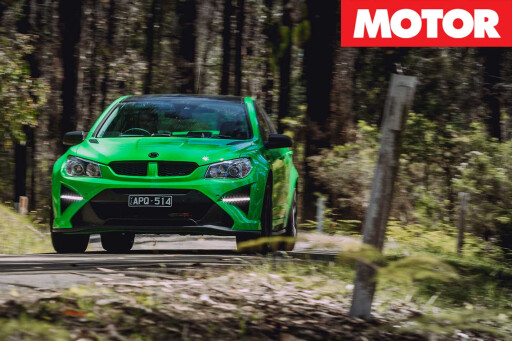 When you do, the experience will be familiar to anyone who’s driven an HSV in the past decade only at a higher level. There’s always a lot of weight to manage and a tendency to understeer if you carry too much corner speed, but equally there’s a lovely neutral mid-corner balance and the choice of a neat or exciting exit depending on throttle application. It gives you options and supports you with one of the most expertly calibrated ESP systems around.
When you do, the experience will be familiar to anyone who’s driven an HSV in the past decade only at a higher level. There’s always a lot of weight to manage and a tendency to understeer if you carry too much corner speed, but equally there’s a lovely neutral mid-corner balance and the choice of a neat or exciting exit depending on throttle application. It gives you options and supports you with one of the most expertly calibrated ESP systems around.
The GTSR chassis is more or less identical to the regular GTS bar one small, but important tweak. Wheel width is increased by a half-inch at both ends and a 6mm increase in front track led to a decrease in offset from 36mm to 33mm. It also necessitated a move to wider plastic front guards, again lifted from the W1 program to help amortise development costs across more than 300 cars.
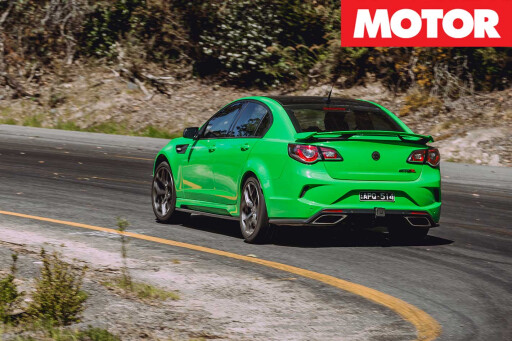 The result is less tyre flex and better steering response, particularly just off-centre where recent HSVs have felt slightly vague. It may sound like a small thing, but it ensures front-end feedback from the moment you start turning the wheel. The trade-off is increased ‘fidgeting’ on rough roads as the front tyres follow bumps and cambers, although it’s rarely a major issue.
The result is less tyre flex and better steering response, particularly just off-centre where recent HSVs have felt slightly vague. It may sound like a small thing, but it ensures front-end feedback from the moment you start turning the wheel. The trade-off is increased ‘fidgeting’ on rough roads as the front tyres follow bumps and cambers, although it’s rarely a major issue.
The revised steering is the final piece in a finely-honed dynamic puzzle and, in the context of a four-door Aussie muscle car, leaves you scratching your head as to how it could be bettered. Sure, the interior can’t match the German premium opposition (though the diamond-quilted Podium seats are ace), but it’s way less than half the price. Some will baulk at an Aussie car wearing a $110,000 price tag, but given the mechanical revisions and updated styling, not to mention its last-of-the-line status, it feels worth the $10K premium over a regular GTS.
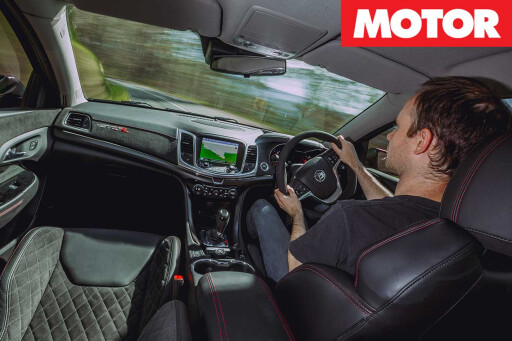 Judging by the number HSV is selling, it seems punters also tend to agree.
Judging by the number HSV is selling, it seems punters also tend to agree.
As such, HSV’s Commodore-based products are retiring at the perfect time. HSV has stretched the Zeta platform, introduced in 2006, to its very limits, finessing it to the nth degree. Without major engineering revisions it’s difficult to see how it could be improved further.
Consider this: in 2006 the VE GTS produced 307kW/550Nm and recorded 0-100km/h and 0-400m sprints of 5.5sec and 13.7sec respectively. The GTSR, using essentially the same platform, packs 435kW/740Nm and knocks 1.5sec off both those benchmarks. Around Winton, even accounting for track improvements the difference would be at least five seconds – probably more.
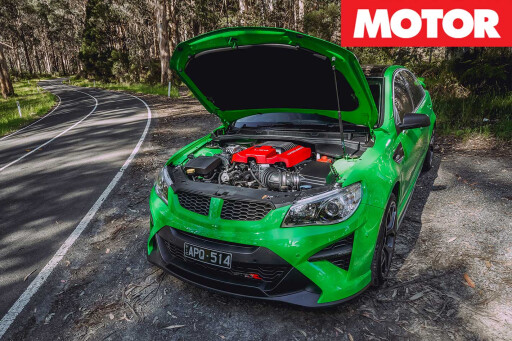 HSV may not have had the luxury of choosing the fate of its local manufacturing operations, but it’s played a hell of a hand with the cards it was dealt. Like the Falcon, the final locally made hot Commodore is the best. However, unlike its Blue Oval nemesis, HSV has had the resource and platform to be able to deliver a globally competitive product right to the very end.
HSV may not have had the luxury of choosing the fate of its local manufacturing operations, but it’s played a hell of a hand with the cards it was dealt. Like the Falcon, the final locally made hot Commodore is the best. However, unlike its Blue Oval nemesis, HSV has had the resource and platform to be able to deliver a globally competitive product right to the very end.
Congratulations on one hell of a career.
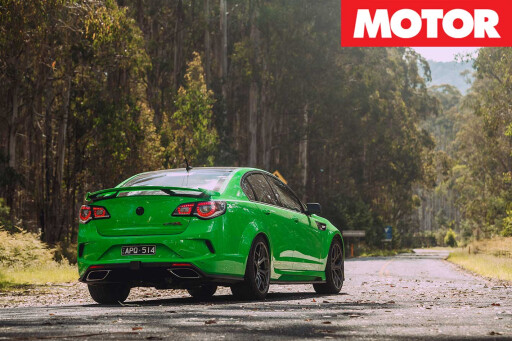 2017 HSV GTSR SPECS:
2017 HSV GTSR SPECS:
Body: 4-door, 5-seat sedan
Drive: rear-wheel
Engine: 6162cc V8, OHV, 16v, supercharger
Bore/Stroke: 103.1 x 92.0mm
Compression: 9.1:1
Power: 435kW @ 6150rpm
Torque: 740Nm @ 3850rpm
Power/Weight: 231kW/tonne
Transmission: 6-speed auto
Weight: 1886kg
Suspension: struts, coil springs, adaptive dampers, anti-roll bar suspension (f); multi-links, adaptive dampers, anti-roll bar (r)
L/W/h: 5044/1899/1468mm
Wheelbase: 2915mm
Tracks: 1616/1590mm (f/r)
Steering: electrically assisted rack-and-pinion
Brakes: 410mm ventilated discs, 6-piston calipers brakes (f); 372mm ventilated discs, 4-piston calipers (r)
Wheels: 20.0 x 9.0-inch (f); 20.0 x 10.0-inch (r)
Tyre sizes: 255/35 R20 (f); 275/35 R20 (r)
Tyre: Continental ContiSportContact 5P
Price as tested: $111,990
Pros: Looks; performance; handling; brakes
Cons: Crazy fuel thirst; it’s goodbye
Rating: 4.5 stars out of 5

COMMENTS